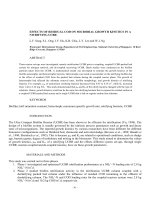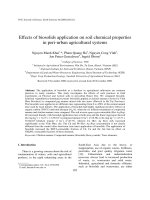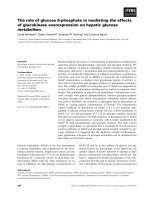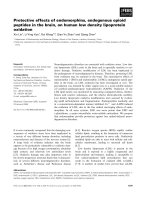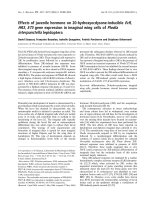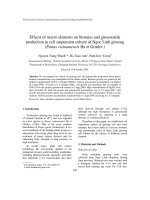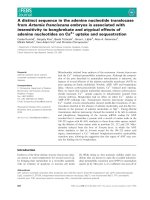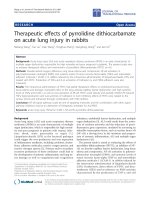Effects of selected chemotherapeutants on nitrification in fluidized sand bioftlters for coldwater fish production
Bạn đang xem bản rút gọn của tài liệu. Xem và tải ngay bản đầy đủ của tài liệu tại đây (2.39 MB, 21 trang )
Effects of Selected Chemotherapeutants on
Nitrification in Fluidized-Sand Bioftlters for
Coldwater Fish Production
M.F. Schwartz, G.L. Bullock, J.A. Hankins,
S.T. Summerfelt, and J.A. Mathias
The Conservation Fund's Freshwater Institute
P. 0. Box 1889, Shepherdstown, WV 25443
ABSTRACT
Four fish chemotherapeutants, formalin, benzalkonium chloride,
chloramine-T, and hydrogen peroxide were evaluated for their effect on
the nitrification efficiency of fluidized-sand biofilters. The
chemotherapeutants were added at conventional concentrations to two
small-scale (2,200 L) coldwater recirculating rainbow trout
(Oncorhynchus mykiss) culture systems each containing six fluidizedsand biofilters operating in parallel. Nitrification efficiency of biofilters
was calculated before and after chemotherapeutant treatments by
determining ammonia removal efficiency at ambient conditions, and also
when challenged with a sudden increase of ammonium chloride at a
concentration four times that of the ambient total ammonia-nitrogen
(TAN). Two formalin treatments in recycle bath mode at 167 and 300
ppm were conducted with only the 300 ppm treatment having a
significant negative effect on biofilter nitrification efficiency. Four single
benzalkonium chloride treatments of one and 2 ppm were conducted;
two static bath treatments and two recycle bath treatments. Of these four
tests, only the recycle bath treatments caused biofilter nitrification
efficiency to be significantly impaired. Two multiple treatments with
benzalkonium chloride were conducted: one static bath treatment and
one recycle.bath treatment. These treatments caused ammonia removal
efficiency to decrease by 18% in the static bath treatment and by 63% in
the recycle bath treatment. Of these two tests, only the recycle bath
treatment caused a significant impairment of nitrification. Single static
bath and recycle bath treatments with 9 ppm of chloramine-T both
resulted in significant impairment of nitrification, as did a 12 ppm
multiple static bath treatment. A single static bath treatment with 100
International Journal of Recirculating Aquaculture, vol. l, no. 1
61
ppm of hydrogen peroxide caused almost total failure of nitrification
within 24 h of treatment but biofilters were able to remove 23% of TAN
within 48 h of treatment.
INTRODUCTION
As land and water resources become increasingly limited, interest in
recirculating aquaculture systems as a sustainable form of food
production is growing. In order to be economical, recirculating systems
must maintain high densities of fish, a condition that provides favorable
conditions for the outbreak and spread of disease (Noble and Summerfelt
1996). Typical. disease treatment protocols often require the availability
of large volumes of water (Noga 1996). Given that one of the primary
reasons for operating recirculating systems is to conserve water,
conducting disease treatments without flushing the system with fresh
water after the treatment would be preferable. In addition, in some cases
there is not enough water available for the complete water exchange
necessary to flush the chemotherapeutant from the system.
A typical recirculating system generally possesses two separate flows:
the system flow, and the make-up flow. The system flow is the internal
flow rate of the water passing through the tanks and other system
components, while the make-up flow is the flow rate of fresh water
entering and leaving the system. In coldwater aquaculture the make-up
flow rate typically ranges from 1-20% of the system flow rate and is
used for the control of temperature and water quality.
The typical methods of disease treatment within recirculating systems
are either a static bath treatment or a flow-through treatment (Noga
1996). Static bath treatments are conducted by treating the culture
organism in a static volume of water followed by flushing. Flow-through
treatments are conducted by allowing water to flow one way through the
system in a single pass and constantly adding the chemotherapeutant to
maintain the desired concentration. Another option, unique to
recirculating systems, is a recycle bath treatment where the chemotherapeutant is added to the culture system under normal operating conditions.
From a disease management perspective, disease treatment using a
recycle bath treatment might be desirable in order to decrease the
possibility that the biofilter could become a reservoir for pathogens
62 International Journal of Recirculating Aquaculture, vol. 1, no. 1
(Noble and Summerfelt 1996). Therefore, recycle bath treatments would
be preferred from the standpoint of efficacy and system management if
the chemotherapeutant did not impair nitrification.
Most tank based aquaculture systems rely on flow and fresh water
inputs to remove toxic metabolites and add oxygen. Treatments that
require static volumes are difficult or impossible to sustain unless special
design considerations, such as in-tank oxygenation and plumbing are
made. Disease treatment using the static bath method will result in a
lower concentration of chemotherapeutant exposure to the biofilters,
because the chemotherapeutant that reaches the biofilters is diluted by
the water volume residing in other compartments of the system once
normal flows are resumed. If static bath treatments are not an option,
then the recirculating aquaculturist must use a recycle bath treatment. A
recycle bath treatment can maintain flow within the culture tank but also
results in a continual exposure of the biofilter to the chemotherapeutant,
which could result in impairment or failure of nitrification.
An important component of recirculating systems, biofilters support
living populations of nitrifying bacteria that transform ammonia and
nitrite, which are toxic to fish, into nitrate, which is relatively non-toxic.
It is important that biofilters operate at peak efficiency during disease
outbreaks because any impairment of biofiltration will serve to increase
the stress on the fish through the reduction of water quality (Klontz
1993). Because of the biological nature of biofilters, they are often
presumed to be sensitive to the biocidal agents added to recirculating
systems for the control of pathogens. For these reasons it is important
that aquaculturists know the effects of cornmonly used chemotherapeutants on biofilters, and how extensive these effects may be. In a
previous study using fluidized-sand biofilters it was determined that
formalin treatments at levels commonly used in fish culture caused no
apparent effect on biofilter performance when tested under ambient
conditions (Heinen et al. 1995). Given that most commonly used
chemotherapeutants in aquaculture are biocides, it was assumed that they
must have some effect on the microbial community associated with
biofilters.
Fluidized-sand biofilters are typically designed with excess
nitrification capacity (Summerfelt 1996; Summerfelt and Cleasby 1996)
in the form of surface area available for microbial colonization. This
International Journal of Recirculating Aquaculture, vol. 1, no. 1 63
capacity allows fluidized-sand biofilters to nitrify more ammonia
and nitrite than they are exposed to under norm.al operating
concentrations. Because of this property it was hypothesized that a
change in the microbial community caused by a chemotherapeutant
treatment that was not evident when a biofi.lter was tested under ambient
conditions would become evident when the biofilter was "challenged"
with a spike of higher than norm.al ammonia concentration. Challenging
the biofilters under norm.al conditions should allow for the determination
of their maximum instantaneous capacity, which could then be used as a
benchmark to compare biofilter performance after exposure to a
chemotherapeutant. If a chemotherapeutant treatment caused an
impairment of maximum biofilter nitrification capacity that was not
apparent under ambient conditions, it should become apparent when the
biofilters are challenged. Hence, it was thought that the effect of
chemotherapeutants on biofilter nitrification capability might be
ascertained through the determination of diminished maximum capacity.
exces~
With this in mind, an investigation into the effect of formalin,
benzalkonium chloride, chloramine-T, and hydrogen peroxide on
biofilter efficiency was undertaken. The goal of this study was to
determine what effect the method of treatment might have on biofilter
efficiency, and to prescribe modifications of these methods to minimize
the effect of a given therapeutant on biofiltration. The four chemicals
tested were chosen because of their widespread historical use in
coldwater aquaculture (Noble and Summerfelt 1996). Form.aldehyde,
benzalkonium chloride and chloramine-T are in use in the countries of
the European Union and Iceland (Schlotfeldt 1990). However, within the
United States, .only formalin is approved by the U.S. Food and Drug
Administration (FDA) for use on food fish. Benzalkonium chloride is
approved for use only as a disinfectant in aquaculture. Hydrogen
peroxide is not approved, but is considered of low regulatory priority and
the FDA is unlikely to obje::t to its use. Attempts to register chloramineT for treatment of bacterial gill disease are presently underway (J.
Bowker, personal communication).
64 International Journal of Recirculating Aquaculture, vol. 1, no. 1
MATERIALS AND METHODS
Recirculating System
All tests were conducted using two identical recirculating systems
(Figure 1). Each system contained one 1,500-L culture tank; one drum
filter; one pump sump; two degassers with sumps; and six identical
biofilters operating in parallel. Each 15 cm inside diameter fluidizedsand biofilter contained 4, 700 cm3 of silica sand and treated a flow of
nine liters/min (L/rnin) for a total system flow rate of 54 L/rnin. The
average diameter of the sand used in the biofilters was 0.17 mm and the
static height of each sand bed was 30.5 cm. The system was stocked with
rainbow trout (Oncorhynchus mykiss) maintained at a density that ranged
from 23-38 kg/m3• Fish were fed continually using mechanical feeders at
a rate of approximately 2% of their body weight per day with Southern
States 3/32" 40% Protein Trout Grower Feed1 (Southern States
Cooperative. Richmond, VA, USA). The make-up flow. a hard spring
water (300 ppm as CaC03) at l l.5°C, was added at a rate of 5% of the
system flow to provide approximately two system volume turnovers per
day. Temperatures within the culture system ranged from 14- l 6°C.
Biofilter influent samples were collected from sampling ports in the
common influent line for each set of three biofilters while biofilter
effluent samples were collected from sampling ports at the top of each
individual biofilter.
BiofillcrS
Culture Tllllk
Figure 1. Diagram of recirculating systems used for chemotherapeutant experiments
International Journal of Recirculating Aquaculture, vol. I, no. I
65
Chemotherapeutant Treatments
Formalin is typically used for the treatment of external parasites at a
concentration of 167 ppm for one hour followed by flushing (Noga
1996). Formalin treatments (37% solution of Formalin-F® 1 (formaldehyde), Natchez Animal Supply, Natchez, MS, USA) were conducted at
167 and 300 ppm in recycle bath mode with single treatments.
A historical treatment for bacterial gill disease with benzalkonium
chloride is to treat with 1-2 ppm for one hour followed by flushing
(Bullock 1990; Noga 1996). Noble and Summerfelt (1996) reported that
an effective treatment technique for benzalkonium chloride was three 2
ppm treatments 48 hours apart. Single treatments of benzalkonium
chloride (50% solution of benzalkonium chloride (dimethyl benzyl
ammonium chloride), Argent Chemical Laboratories 1, Redmond, WA,
USA) were conducted using both static bath and recycle bath treatments
at 1 and 2 ppm. Multiple treatments, consisting of three treatments 48 h
apart, with benzalkonium chloride at 2 ppm were also conducted in both
static bath and recycle bath mode.
Chloramine-T is used as a bactericide at concentrations ranging from
9-12 ppm for one-hour static bath treatments either singly, or in a series
of three treatments given on alternate days (Bills et al. 1988; Bullock et
al. 1991). Single static bath and recycle bath treatments with 9 ppm of
chloramine-T (N-chloro-p-toluene sulfonamide sodium salt, Sigma
Chemical Co. 1, St. Louis, MO, USA) were conducted first, and then a
multiple static bath treatment consisting of three treatments at 12 ppm
was performed on alternate days.
Hydrogen peroxide is used as a bactericide and fungicide with a one
hour static bath treatment at concentrations ranging from 100-500 ppm
(Arndt and Wagner 1997; Rach et al. 1997). The hydrogen peroxide
treatment (35% solution of Peroxyclear® 1 (hydrogen peroxide), EKA
Chemicals, Marietta, GA, USA) consisted of one static bath treatment at
100 ppm. This concentration was chosen because previous unpublished.
work indicated that the peroxide treatment would significantly impair
biofilter performance. Hence, a concentration at the lower end of the
reported range was chosen.
Use of trade names or specific manufacturers or suppliers does not
indicate endorsement.
1
66 International Journal of Recirculating Aquaculture, vol. 1, no. 1
Before a given chemotherapeutant test the ambient biofilter water
chemistry was analyzed, then the biofilters were challenged. The
chemotherapeutant was added to the system immediately after the
challenge. Chemotherapeutant concentration was determined every
twenty minutes in the culture tank and in the biofilter influent and
effluent lines. Formalin concentrations were measured directly using the
Purpald colorimetric method (Chemetrics 1, Calverton, VA, USA). The
concentration of benzalkonium chloride was determined by analyzing the
quaternary ammonium compounds (QAC) present in the water using the
Direct Binary Complex colorimetric method (Hach Chemical Co. 1,
Loveland, CO, USA) and establishing the relationship between
benzalkonium chloride concentration and measured QAC. The
concentration of chloramine-T was determined by analyzing the
concentration of total chlorine present in the water using the DPD (N, Ndiethyl-p-phenylenediamine) method (Hach Chemical Co., Loveland,
CO, USA) and establishing the relationship between calculated
chloramine-T concentration and measured free chlorine. Hydrogen
peroxide concentrations were measured directly using the thiocyanate
method (Chemetrics, Calverton, VA, USA).
At least 4 weeks were allowed to elapse between tests with a given
chemotherapeutant to allow the microbial flora of the biofilters time to
stabilize from any perturbations caused by previous treatments. The
maximum time that elapsed between the conclusion of one set of
chemotherapeutant tests and the onset of tests with the next chemotherapeutant was two months.
Static Bath Treatments
Static bath treatments were conducted by turning off the make-up flow
to prevent dilution of the chemotherapeutant, and isolating the biofilters
in a separat~ recirculating loop to maintain fluidization. The
chemotherapeutant was then added to the static culture tank and the
above conditions were maintained for an hour after which normal
operating conditions were resumed. In this type of treatment, biofilters
were exposed to the chemotherapeutant only after normal operations
were resumed, at which time the chemotherapeutant would have been
diluted by water volume residing in other compartments of the system. In
the case of this experiment, chemotherapeutants in the culture tank were
diluted by 40% once normal operations were resumed.
International Journal of Recirculating Aquaculture, vol. l, no. 1 67
Recycle Bath Treatments
Recycle bath treatments were conducted by leaving all flow processes
in their normal mode with the only difference being that the make-up
flow was turned off to prevent dilution of the chemotherapeutant. The
chemotherapeutant was then added in aliquots throughout the system.
Normal make-up flow operating conditions were resumed after one hour.
During recycle bath treatments the biofilters were left connected to the
main flow and as such were continually exposed to the chemotherapeutant during treatment.
Ammonia Challenge Tests
As a preliminary step the biofilters were challenged at various total
ammonia nitrogen (TAN) concentrations up to five times higher than
ambient in order to determine the maximum TAN concentration that
could be assimilated without a significant drop in biofilter efficiency. A
TAN concentration five times higher than ambient resulted in a
significant reduction in ammonia removal (30% ), whereas at
concentrations approximately four times higher than ambient, there was
very little diff~rence in biofilter efficiency under ambient and challenge
conditions.
The fact that a recirculating system was used required two issues to be
addressed by the experimental design in order for the challenge test to be
successful: time of sample collection, and prevention of contamination
by the recirculating spike. The time when the peak concentration of
injected TAN occurred was determined by proportionally metering a
concentrated solution of ammonium chloride into the system pump
intake. Samples were then collected at the site of biofilter influence
every 30 sec and analyzed for TAN. The time required for injected
material to recirculate back to the point of injection was determined by
injecting a 10 mL aliquot of dye(red food coloring) into the pump intake
and collecting samples at regular intervals. The absorbance of these
samples was recorded at 500 nm with a Hach DR2000 spectrophotometer. It _typically took 9-10 min for the dye to return to the point of
injection at the pump intake. The hydraulic retention time of the
biofilters was approximately 20 sec. The TAN concentration reached a
peak at 5 min after injection. To achieve a consistent TAN spike
concentration across tests, the biofilter influent and effluent, samples
were collected at precisely six min after the onset of the ammonium
68 IntemationalJoumalofRecirculatingAquaculture, vol. l, no.1
chloride solution injection. Collecting the samples at six min was long
enough to ensure that the ammonia concentration was at its peak level
but was still short enough to prevent the ammonia spike from
recirculating through the system.
Before and 24 h after each chemotherapeutant treatment, ambient
biofilter performance was measured and then the biofilters were
challenged with a spike of ammonium chloride solution approximately
four times that of the ambient influent TAN concentration. The
ammonium chloride solution (8.93 g NH4 Cl/L) was metered directly into
the pump intake for six minutes with samples collected from the biofilter
influent and effluent at the end of this time period. Parameters measured
were: temperature, pH, dissolved oxygen, TAN, and nitrite-nitrogen.
Water quality parameters were all analyzed according to standard
methods (APHA 1989).
Biofilter nitrification efficiency was calculated by subtracting the
outlet concentration from the inlet concentration and dividing the
difference by the inlet concentration. The statistical significance of
differences between removal efficiencies was determined using a onetailed Wilcoxon paired-sample test (Zar 1974) on the mean of six
biofilters. A non-parametric test was chosen because the data was not
distributed :µormally.
The experimental protocol and methods described were in compliance
with Animal Welfare Act (9CFR) requirements and were approved by the
Freshwater Institute Institutional Animal Care and Use Committee.
RESULTS
Under ambient conditions, influent concentrations for TAN and nitrite
ranged from 0.18-0.52 mg/Land 0.009-0.086 mg/L, respectively (after
treatment with hydrogen peroxide the ambient TAN peaked at 1.8 mg/L
and dropped back to normal levels after three days). During the biofilter
challenges influent concentrations of TAN and nitrite ranged from 1.07 1.52 mg/Land 0.014-0.105 mg/L, respectively. Total suspended solids
measuremep.ts during the testing period averaged 2.9 mg/L with little
difference between biofilter influent and effluent being observed.
International Journal of Recirculating Aquaculture, vol. 1, no. 1 69
Table 1. Summary ofeffects offormalin recycle bath treatments on
biofilter nitrification efficiency. Values are means of six biofilters with the
standard error. Double asterisks indicate a highly significant difference
(p<0.01 between before and after values for one particular test.
Removal Efficiency
Treatment
167 ppm Formalin
Before
After (24 h)
300 ppm Formalin
Before
After (24 h)
Ambient TAN
Challenged TAN
0.91 ± 0.02
0.90 ± 0.04
0.69 ± 0.04
0.81 ± 0.06
0.79 ± 0.02
0.76 ± 0.03
0.68 ± 0.05**
0.55 ± 0.06
Table 2. Summary of single benzalkonium chloride treatments at different
concentrations and treatment modes and their effect on biofilter nitrification
efficiency. Values are means ofsix biofilters with the standard error. Single
asterisks indicate a significant difference (p<0.05) between before and after
values for one particular test, while double asterisks indicate a highly
significant difference (p<0.01).
Removal Efficiency
Treatment
Ambient TAN
1 ppm Benzalkonium Chloride Static Bath
Before 0.76 ± 0.02
0.95 ± 0.03
After (24 h)
1 ppm Benzalkonium Chloride Recycle Bath
Before 0.79 ± 0.02
After (24 h)
0.82 ± 0.02
2 ppm Benzalkonium Chloride Static Bath
Before 0.35 ± 0.03
After (24 h)
0.85 ± 0.04
2 ppm Benzalkonium Chloride Recycle Bath
Before 0.96 ± 0.03*
0.74 ± 0.10
After (24 h)
Challenged TAN
0.79 ± 0.04
0.82 ± 0.05
0.78 ± 0.05**
0.68 ± 0.06
0.61 ± 0.03
0.68 ± 0.05
0.83 ± 0.06**
0.56 ± 0.11
70 International Journal of Recirculating Aquaculture, vol. 1, no. 1
The concentration of formalin remained relatively constant during the
tests while the concentration of benzalkonium chloride decreased by
about 50% over the space of an hour. During static bath treatments the
concentration of chloramine-T decreased on average by 18%. The
decrease in chloramine-T concentrations during recycle bath treatments
averaged 43%. The concentration of hydrogen peroxide declined by 25%
during the last 30 min of treatment after staying constant for the first 30
min.
The 167 ppm formalin test produced a slight reduction in ambient
TAN removal (AAR) and a 12% increase in challenged TAN removal
(CAR) (Table 1). After the 300 ppm formalin treatment there was a slight
decrease of both AAR and CAR.
A 1 ppm benzalk.onium chloride single static bath treatment resulted in
a slight increase of both AAR and CAR (Table 2). The single 1 ppm
benzalkonium chloride recycle bath treatment resulted in a slight
increase of AAR and a 10% decrease in CAR. The single 2 ppm
benzalk.onitim chloride static bath treatment caused an increase in both
AAR and CAR. Of the single benzalkonium chloride treatments, the
most dramatic effect was observed in the 2 ppm recycle bath treatment.
Both AAR and CAR were reduced by over 20%. There was an 18%
reduction of both AAR and CAR after the end of the multiple
benzalkonium chloride static bath treatment. At the end of the multiple
recycle bath treatment AAR had decreased by 63% and CAR by 46%
(Table 3). The comparative effects of the multiple benzalk.onium chloride
treatments are displayed in Figure 2.
After the 9 ppm single chloramine-T static bath treatment AAR
increased 20% and CAR decreased 5% (Table 4). The AAR decreased
10% and the CAR decreased 9% after the 9 ppm single chloramine-T
recycle bath treatment. After the set of multiple 12 ppm chloramine-T
static bath treatments there was only a slight decrease in AAR while
CAR decreased by 8%. The longer term effects of the chloramine-T
treatments are displayed in Figure 3.
The 100 ppm single hydrogen peroxide static bath treatment caused
almost total impairment of nitrification (Table 5). Twenty-four hours
after treatment the AAR was reduced by 84% and the CAR by 57%.
From Figure 4, it can be seen that the biofilters had significantly
recovered 1.1 days after treatment.
International Journal of Recirculating Aquaculture, vol. 1, no. 1 71
e-
a>
o_s
·o=
c
~
~
0.6
>
Q
e
a>
:: J
i
z
CZ::
~
"·~ . i-·-I .;
l
T
T
... -.···-·-·-t
~
i"·f-·-f-····
- -·
~Static Treatment
·> · ~
.. i -----t~-....,......___:;.,
J.J
~
• • • - Recycle Treatment
.
=··;::·~====::;----'
(t
Days after initial treatment
Figure 2. Effect ofmultiple benzalkonium chloride treatments (static bath and
recycle bath) on challenged biofilter TAN removal efficiency. Values are
means ±standard errors ofsix biofilters.
Table 3. Summary of effects ofthree consecutive benzalkonium chloride
treatments on biofilter efficiency under two different treatment modes. Values
are means ofsix biofilters with the standard error. Double asterisks indicate a
highly significant difference (p<0.01) between initial and.final values for one
particular test.
Removal Efficiency
Treatment
Ambient TAN
2 ppm Benzalkonium Chloride
(Three Static Bath Treatments/Alternate Days)
Before 0.86 ± 0.04
0.87 ± 0.05
After (24 h)
Before 0.64 ± 0.04
After (24 h)
0.78 ± 0.06
Before 0.59 ± 0.06
After (24 h)
0.68 ± 0.08
2 ppm Benzalkonium Chloride
(Three Recycle Bath Treatments/Alternate Days)
Before 0.96 ± 0.03**
After (24 h)
0.74 ± 0.10
Before 0.71 ± 0.10
0.54 ± 0.15
After (24 h)
Before 0.52 ± 0.15
After (24 h)
0.33 ± 0.12
Challenged TAN
0.86
0.77
0.72
0.69
0.73
0.68
± 0.04
± 0.11
± 0.12
0.83
0.56
0.53
0.46
0.43
0.37
±
±
±
±
±
±
± 0.08
± 0.08
± 0.08
0.06
0.11
0.07
0.08
0.08
0.07
72 International Journal of Recirculating Aquaculture, vol. 1, no. 1
Table 4. Summary ofchloramine-T treatments at different concentrations and
treatment modes and their effect on biofilter nitrification efficiency. Values are
means ofsix biofilters with the standard error. Single asterisks indicate a
significant difference (p<0.05) between before and after values for one
particular test, while double asterisks indicate a highly significant difference
(p<0.01 ). For the 12 ppm chloramine-T tests asterisks indicate significant
difference between initial andfinal values.
Removal Efficiency
Ambient TAN
Treatment
9 ppm Chloramine-T Static Bath
Before 0.71 ± 0.03
After (24 h)
0.91 ± 0.02
9 ppm Chloramine-T Recycle Bath
Before 0.80 ± 0.03**
After (24 h)
0.70 ± 0.01
12 ppm Chloramine-T
(Three Static Bath Treatments/Alternate Days)
Before 0.85 ± 0.03
After (24 h)
0.94 ± 0.01
Before 0.85 ± 0.01
After (24 h)
0.77 ± 0.04
Before 0.99 ± 0.01
After (24 h)
0.84 ± 0.02
Challenged TAN
0.65 ± 0.06*
0.60 ± 0.05
0.89 ± 0.03**
0.80 ± 0.05
0.81
0.79
0.82
0.83
0.74
0.73
± 0.06**
± 0.07
± 0.08
± 0.08
± 0.09
± 0.08
Table 5. Summary ofeffects ofstatic bath treatment with hydrogen peroxide on
biofilter nitrification efficiency. Values are means ofsix biofilters with the
standard error. Double asterisks indicate a highly significant difference
(p<0.01) between before and after values for one particular test.
Removal Efficiency
Treatment
Ambient TAN
100 ppm Hydrogen Peroxide
Before
After (24h)
0.85 ± 0.03**
0.01 ± 0.01
Challenged TAN
0.61 ± 0.08**
0.04 ± 0.06
International Journal of Recirculating Aquaculture, vol. 1, no. 1 73
e....=
Q.I
c
.....
CJ
r.'l
o:~
---.. -... --~. -....... .... -. -..... _
I.
0.6
~
Q.I
z
~
~
l
0.4.;
e= !
~
-:
--+- 9 ppm Single Recycle
o.: 1
- - • • · 12 ppm Multiple Static
0
s
6
2
10
12
Days after initial treatment
Figure 3. Effect ofsingle and multiple chloramine-T treatments on challrmged
bio.filter TAN removal efficiency. The multiple treatments ended on day 5.
Values are means ±standard errors ofsix bio.filters.
/
2
....
6
s
10
!2
Days after initial treatment
Figure 4. Effect ofsingle 100 ppm hydrogen peroxide static bath treatment on
ambient biofilter TAN removal efficiency. Values are means ofsix biofilters.
Ambient values were used because ambient TAN values rose high enough after
the treatment to render biofilter challenge superfluous.
7 4 International Journal of Recirculating Aquaculture, vol. I, no. I
DISCUSSION
The primary goal in this research was to determine which of the
chemotherapeutants evaluated affect biofilter performance, and to what
effect, with the overall concern being the preservation of adequate water
quality for fish rearing. As long as adequate water quality can be
maintained, minor drops in biofilter efficiency can be tolerated. Within
the recirculating aquaculture system used in these experiments, biofilter
nitrification efficiency often fluctuates from 5-10% over a period of
several days without significant effects on water quality (unpublished
data). The authors chose to make the distinction between significant
(p<0.05) and highly significant (p<0.01) statistical differences in biofilter
efficiency because it was assumed that only highly significant
differences would have a biologically significant effect on biofiltration
and the resulting water quality. The effect of changes in nitrification
efficiency on TAN concentrations can be illustrated using Liao and
Mayo's (1972) equation for calculating steady-state concentrations in
recirculating systems. For example: assuming an initial removal
efficiency of 90%, a 10% decrease in TAN removal efficiency will
increase the tank TAN concentration by 12%; a 20% decrease will
increase it by 27%; while a 60% decrease will increase it by 170%.
TAN- {
-
1
} pTAN
•----1 - R + (R • frem)
Q
TAN= total ammonia-nitrogen, mg/L
R= recycle fraction, decimal
f rem= TAN removal efficiency, decimal
P TAN= daily production of TAN, kg/d
Q= system flow, L/min
Of the tw_o formalin treatments, only the single 300 ppm formalin
recycle bath treatment caused significant impairment of TAN removal
and only within the CAR component. In comparison, Weinbeck and
Koops (1990) found that indefinite treatments with 149 ppm formalin
had an adverse affect on nitrification in their biofilters, while Heinen et
al. (1995) found indefinite treatments at 120 ppm, and one hour
treatments at 167 ppm, had no effect on nitrification.
International Journal of Recirculating Aquaculture, vol. l, no. 1 75
Both of the single benzalkonium chloride recycle bath treatments (1
and 2 ppm) caused significant impairment of CAR. Of these two tests
unly the 2 ppm test caused a significant reduction of AAR. This
impairment of nitrification would be expected, since this test resulted in
the highest concentration of benzalkonium chloride that the biofilters
were exposed to. With multiple benzalkonium chloride treatments, only
the 2 ppm recycle bath treatments significantly impaired TAN removal.
Similarly, Noble and Summerfelt (1996) reported that 2 ppm
benzalkonium chloride treatments had a negative impact on biofilters at a
coldwater hatchery.
All of the chloramine-T treatments caused a significant reduction of
CAR, while only the single 9 ppm chloramine-T recycle bath treatment
caused a significant reduction of both AAR and CAR. In contrast, Noble
and Summerfelt (1996) reported that treatment with 12 ppm of
chloramine-T had no effect on biofilters at a coldwater hatchery.
The single 100 ppm hydrogen peroxide treatment caused significant
reduction of both AAR and CAR. As there was limited literature
available on the effect of hydrogen peroxide treatments on biofilters, the
authors had to rely on anecdotal information for comparison. As such,
Bullock and others at the Freshwater Institute have observed hydrogen
peroxide treatments at 100 ppm to cause a major impairment of biofilter
efficiency (unpublished data).
The tests having a highly significant impact on both AAR and CAR
were: multiple 2 ppm benzalkonium chloride recycle bath; single 9 ppm
chloramine-T recycle bath; and single 100 ppm hydrogen peroxide static
bath. These treatments should be avoided in recirculation systems as they
could cause major changes in water quality.
Treatments having a highly significant effect on CAR only were:
single 300 ppm formalin recycle bath; single 2 ppm benzalkonium
chloride recycle bath; single 1 ppm benzalkonium chloride recycle bath;
and multiple 12 ppm chloramine-T static bath. These treatments could
also cause significant impairment of water quality in a recirculating
system.
Regardless of treatment type or concentration, chloramine-T and
hydrogen peroxide consistently impaired nitrification. The severe impact
76 International Journal of Recirculating Aquaculture, vol. l, no. 1
of hydrogen peroxide would make it suitable for use as a
chemotherapeutant in recirculating systems only if completely flushed
out of the system or completely inactivated before resuming normal
operations. Chloramine-T could possibly be used with caution in a static
bath treatment at the lowest concentration possible. Both formalin and
benzalkonium chloride did not cause impairment of nitrification at lower
concentrations, hence they could probably be used safely at these
concentrations with a static bath treatment being the preferred mode of
application. Aquaculturists considering the use of chemotherapeutants in
recirculating systems should exercise caution as it is difficult to predict
the potential effects of these chemotherapeutants on other types of
recirculating systems. They should also be aware that the effect of a
given chemotherapeutant on water quality will depend on the type of
biofilter and ambient water quality. Our experience has been that
fluidized-sand biofilters are particularly resilient to perturbations. The
maintenance of good water quality should provide an adequate buffer in
the event of a low-level, temporary biofilter impairment caused by a
chemotherapeutant treatment.
The results of this research support the hypothesis that impairment of
nitrification in fluidized-sand biofilters can be determined through
challenging the biofilters with high concentrations of TAN. In all cases
where AAR was significantly impaired, CAR was also significantly
impaired. In two of the tests only CAR was significantly impaired,
indicating that the nitrifiers within the biofilter were affected by the
chemotherapeutant without any apparent effect on AAR. Excluding
hydrogen peroxide, the results of this research show that while biofilters
were all impaired to a certain extent by the chemicals used, the effect
was primarily related to concentration. It should be kept in mind that the
static bath treatments with the same concentration as recycle bath
treatments resulted in lower biofilter exposure concentrations. This
brings up the need for further research to test the efficacy of longer
duration di~ease treatments at lower concentrations and the effect of
these long duration treatments on biofilters.
The fact that chemotherapeutants are effective at reducing or
eliminating fish pathogens and relatively ineffective at eliminating
microbes within a biofilter is not surprising. In order to become
permanently established within a biofilter nitrifying bacteria must form
biofilms (Hagopian 1998). Bacteria can protect itself from antimicrobial
International Joumal of Recirculating Aquaculture, vol. 1, no. 1 77
agents through the production of a film of hydrated exopolysaccharides
(EPS) and are inherently more resistant to antimicrobials than their
planktonic forms (Costerton et al. 1995). Since the concentrations
required for disinfection with benzalkonium chloride and formalin are
200 ppm and 10,000 ppm respectively (Stoskopf 1993), it is not
surprising that the concentrations used in these experiments did not have
a greater effect on the biofilters with their well-established populations
of nitrifiers. Such high concentrations are necessary because disinfection
is generally directed against biofilms (Block 1991). LeChevallier (1991)
reports that it generally requires 150 times the CT factor (concentration x
time) of hypochlorous acid to achieve the same reduction in activity in a
biofilm as aga~nst planktonic forms. In addition, microbes use calcium
and magnesium ions in the production ofEPS (Costerton et al. 1995).
Anderson (1985) reported that Rocca!®, a quaternary ammonium
compound analogous to benzalkonium chloride, was more toxic to
biofilters in soft waters than in hard waters. The water used in this
experiment was hard, which may explain why benzalkonium chloride
was not observed to cause greater impairment of the biofilter. While the
resistance of bacteria within biofilms to antimicrobials allows a margin
of safety, the aquaculturist who uses antimicrobials should still exercise
caution, as it appears that repeated use may have serious consequences
on biofilter performance.
ACKNOWLEDGEMENTS
This research was funded by the U.S. Dept. of Agriculture's
Agriculture Research Service under agreement 59-1931-3-012 and any
opinions, findings, conclusions, or recommendations expressed in this
publication are those of The Conservation Fund or the authors and do not
necessarily represent those of the USDA.
78 International Journal of Recirculating Aquaculture, vol. l, no. 1
REFERENCES
American Public Health Association (APHA). 1989. Standard Methods
for the Examination of Water and Wastewater. APHA,
Washington, D.C.
Anderson, A.R. Effects of Therapeutic Disease Treatments on
Nitrification in Model Water Recycle Systems: A Preliminary
Study 1985. Technology Transfer Series No. 84-1. U.S. Fish and
Wildlife Service.
Arndt, R.E., Wagner, E.J. The Toxicity of Hydrogen Peroxide to
Rainbow Trout and Cutthroat Trout Fry and Fingerlings. Journal
ofthe World Aquaculture Society 1997, 28(2), 150-157.
Bills, T.D., Marking, L.L., Dawson, V.K., Rach, J.J. Effects of
Environmental Factors on the Toxicity of Chloramine-T to Fish.
Investigations in Fish Control No. 961988. U.S. Fish and
Wildlife Service.
Block, S.S. 1991. Disinfection. Sterilization and Preservation. Lea &
Febiger, Philadelphia, Pennsylvania.
Bullock, G.L. Bacterial Gill Disease of Freshwater Fishes. Fish Disease
Leaflet 841990. U.S. Fish and Wildlife Service.
Bullock, G.L., Herman, R.L., Waggy C. Hatchery Efficacy Trials with
Chloramine-T for Control of Bacterial Gill Disease. Journal of
Aquatic Animal Health 1991, 3, 48-50.
Costerton, J. W., Lewandowski, Z., Caldwell, D. E., Korber, D. R.,
Lappin-Scott, H. M. Microbial Biofilms. Annual Review of
Microbiology 1995, 49, 711-745.
Hagopian, D.S., Riley, J. G. A Closer Look at the Bacteriology of
Nitrification. Aquacultural Engineering 1998, 18(4), 223-244.
International Journal of Recirculating Aquaculture, vol. 1, no. I
79
Heinen, J.M., Weber, A.L., Noble, A.C., Morton, J.D. Tolerance to
Formalin by a Fluidized-Bed Biofilter and Rainbow Trout in a
Recirculating Culture System. Journal ofthe World Aquaculture
Society 1995, 26(1), 65-71.
Klontz, G.W. Environmental Requirements and Environmental Diseases
of Salmonids. In: Fish Medicine, Stoskopf, M.K. (ed.), W.B.
Saunders, Philadelphia, Pennsylvania, 1993.
LeChevallier, M.W. Biocides and the Current Status of Biofouling
Control in Water Systems. In: Biofouling and Biocorrosion in
Industrial Water Systems, Flemming, H.-C., and Geesey, G.G.,
(eds.), Springer-Verlag, Berlin, Heidelberg, 1991.
Liao, P.B., Mayo, R.D. Salmonid Hatchery Water Reuse Systems.
Aquaculture 1972, 1, 317-335.
Noble, A.C., Surnmerfelt, S.T. Diseases Encountered in Rainbow Trout
Cultured in Recirculating Systems. Annual Review of Fish
Diseases 1996, 6, 65-92.
Noga, E.J. 1996. Fish Disease: Diagnosis and Treatment. Mosby-Year
Book, St. Louis, Missouri.
Rach, J.J., Schreiber, T.M., Howe, G.E., Redman, S.D. Effect of Species,
Life Stage, and Water Temperature on the Toxicity of Hydrogen
Peroxide to Fish. Progressive Fish-Culturist 1997, 59, 41-46.
Schlotfeldt, HJ. Current Practices of Chemotherapy in Fish Culture. In:
Chemotherapy in Aquaculture: From Theory to Reality, Michel,
C., Alderman, D. (eds.), Office International des Epizooties,
Paris, France,1990.
Stoskopf, M.K. 1993. Fish Medicine. W.B. Saunders, Philadelphia, PA.
Surnmerfelt, S.T. Engineering Design of a Water Reuse System. In:
Walleye Culture Manual, Surnmerfelt, R.C. (ed.), NCRAC
Culture Series I 0 I. North Central Regional Aquaculture Center
Publications Office, Iowa State University, Ames, Iowa, 1996.
80 International Journal of Recirculating Aquaculture, vol. l, no. 1
Sumrnerfelt, S.T., Cleasby, J.L. A Review of Hydraulics in FluidizedBed Biological Filters. Transactions ofthe ASAE. 1996, 39,
1161-1173.
Weinbeck, H., Koops, H. Decomposition of Formaldehyde in
Recirculation Systems. Archiv fur Fischereiwissenschaft 1990,
40, 153-166.
Zar, J.H. 1974. Biostatistical Analysis. Prentice-Hall, Englewood Cliffs,
NJ.
International Journal of Recirculating Aquaculture, vol. l, no. 1 81
